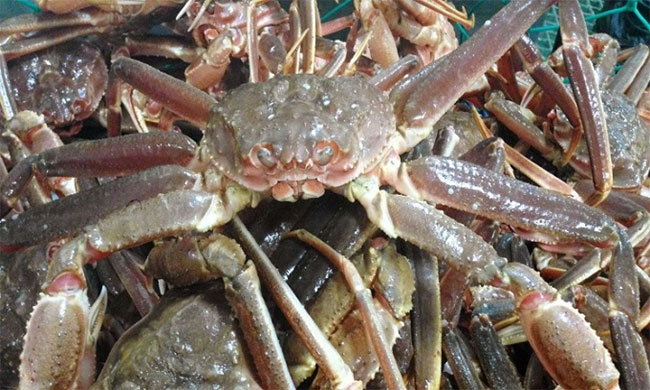For the first time, authorities have postponed the harvest of Alaskan snow crabs due to billions of crabs disappearing from the Bering Sea in recent years.
The Alaska Fisheries Commission and the North Pacific Fishery Management Council announced last week that the snow crab population in the Bering Sea has fallen below normal thresholds. The number of snow crabs decreased from approximately 8 billion in 2018 to 1 billion in 2021, according to Benjamin Daly, a researcher at the Alaska Department of Fish and Game.

The snow crab population is experiencing a severe decline. (Photo: Alaska Journal)
“Historically, snow crabs have been the most abundant commercially harvested crabs in the Bering Sea. Therefore, the disappearance of billions of crabs from the population, including all female crabs and juveniles, is quite remarkable,” Daly stated.
Authorities also announced a second consecutive year of halting the harvest of red king crabs in Bristol Bay. The reason provided was overfishing. Mark Stichert, the bottom fish and shellfish management coordinator at the Alaska Department of Fish and Game, noted that the number of crabs harvested exceeds the number of naturally replacing crabs. He indicated that in surveys conducted in 2021 and 2022, the population of mature male snow crabs decreased by about 40%. However, this alone cannot explain the population collapse, emphasized Michael Litzow, director of the Kodiak Laboratory at NOAA Fisheries.
Litzow stated that human-induced climate change is a significant factor contributing to the alarming disappearance of snow crabs. This species thrives in cold water and is found in areas with water temperatures below -2 degrees Celsius. As the oceans warm and sea ice disappears, the waters around Alaska have become increasingly inhospitable for this species.
Temperatures in the Arctic are rising four times faster than in other parts of the world. Climate change is causing Arctic sea ice to vanish rapidly, particularly in the Bering Sea off Alaska. The fishing ban due to low numbers and continued research are essential efforts to restore the population at this time, according to Ethan Nichols, a regional management biologist at the Alaska Department of Fish and Game.
Currently, some young, immature snow crabs have begun to appear in the area. However, it will take at least another 3 to 4 years for them to mature and contribute to the recovery of the overall species population.
In fact, snow crabs are a delicacy, consumed in large quantities. Alaskan snow crabs typically sell for $25 per pound (approximately $50 per kilogram), significantly cheaper than king crabs. In Vietnam, the price of whole snow crabs is currently advertised at around 1.8 million VND per kilogram. Snow crab legs are priced at 650,000 VND per kilogram.
In Japan, the catch of this species is restricted, making their price relatively high and primarily serving domestic demand. In an auction in Tottori Prefecture, Japan, at the end of 2019, a single snow crab was sold for a record price of 5 million yen (46,000 USD).


















































